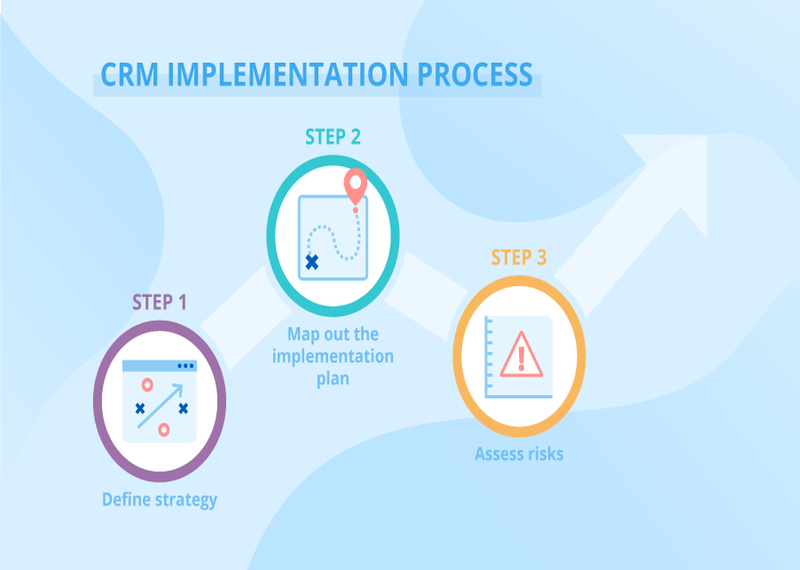What to consider when implementing a CRM system?

Customer relationship management (CRM) software has evolved from a tool to help sales teams store customer data to a versatile node that manages an entire enterprise's technology suite. It can add huge value to your business, but its effectiveness is determined by how well it integrates with your existing processes.
Learn how to implement CRM software in six steps to make it a success for your team and your customers.
- The enhanced features of CRM software have also increased the complexity and need for the software.
- Nearly half of CRM implementation campaigns suffer from inadequate preparation and misaligned goals among internal stakeholders.
- A well-planned CRM implementation strategy includes a breakdown of goals, research, strategy, development and future.
Best implementation practices include focusing on the goals you have set, hiring a dedicated team to lead the implementation, and offering training opportunities that help employees understand how to use the software during the implementation.
How to implement a CRM system
A CRM platform is a comprehensive system overhaul and the scale and detail of the implementation should match the intended scope. These six key concepts clarify the investment required and the strategies that businesses can follow for a successful CRM implementation.
1. Identify realistic, achievable goals.
You need to have a clear and simple vision for CRM that is directly linked to your core business functions. List the macro objectives, describe your overall vision of the impact of CRM, and specify exactly which CRM functions and the tools provided will help you achieve them.
A common mistake when looking for such systems is to view the platforms as add-ons - extensions, not integrations. CRM systems do add new processes and functionality, but these are benefits, not goals. Indeed, they can even distract from the primary mission. Ask yourself some guiding questions when considering whether CRM software is right for your business: Will the new system fit the way you do business? Are you looking to streamline a process or change it completely?
2. Do your research to find the right CRM solution.
As the fastest growing business software, CRM offers a huge field of possibilities. Your specific mission statement is the most useful constraint, but narrowing down the top three CRMs to your final choice is much harder than narrowing down an oversized list. There is no single right or wrong answer - this is not a math test - but some answers are still more correct than others.
The most important factors in your decision may be pricing, the fit of the CRM tools to your processes, ease of use and available integrations. Keep the initial implementation simple, but also keep in mind the implications of future upgrades. A simple but successful implementation is preferable in the short and long term to an overly ambitious one that is beyond your scope.
3. Select a CRM team of departmental champions.
Once you've selected the CRM platform that best fits your business vision, mobilise the creative team. This requires a dedicated team to carry out day-to-day tasks and manage progress. The team should consist of the following members:
- Project manager (leader)
- System developer (deployment)
- Data Analyst (data migration)
- Quality assurance engineer (testing)
- Champions (representatives)
Depending on the size of your business and the scale of your CRM implementation, there may be more than one person in each role.
4. Forecasting costs and benefits.
Work with the different teams to forecast the specific impact CRM will have on the business during the implementation process, in the first six months after implementation when the team is acclimatised, and in the following 12 months when CRM becomes an integral part of everyday use.
The most useful reports include cost-benefit analyses and implementation roadmaps. Remember that at different stages of implementation, production may decline. Resources will be focused on deployment while employees learn new practices, and overhead costs may increase depending on the training and consulting services chosen.
These specific numbers provide more accurate expectations that can help you adjust achievable goals and gain the support of your management team. Metrics that demonstrate the expected improvement in customer retention and conversion rates will convince even the most skeptical. But don't dismiss their feedback - they may notice a hidden detail, and this reluctance can spill over to other staff when inevitable pain points arise during the learning process.
5. Migrate and integrate data.
Cleaning the data and migrating it to the new CRM platform will be the longest part of the implementation. Even migrating your ideal data set of customers, finances and messaging services with completely correct and up-to-date information will take several weeks. Missing or incorrect data must be retrieved and corrected, otherwise it will reduce the effectiveness of your CRM.
6. Train your team and test the system.
Once the CRM platform is operational, assign your representatives to spearhead training initiatives along with the general staff. By this time, your reps should be familiar with the system, its benefits and how to use the tools.
Most CRM offerings include training and consulting programmes to help businesses get the most out of the platform. During this testing phase, engage your IT team to carry out quality assurance tests. Some bugs are unavoidable, but you don't want the initial rollout to be overshadowed by a lot of urgent IT fixes while the system is live.
The importance of CRM implementation
A new CRM system will upset many established processes in your team, so your plan should naturally integrate this new system into current workflows to prepare employees for the launch. The right implementation process will minimise the time needed for employees to get to grips with the tools and also reduce risks.
An unprepared team will be less productive as they juggle daily tasks while learning the system. Mistakes made while using the software, such as losing data or miscommunicating with your team, can hurt revenue and customer relationships.
The more segments CRM touches, the more extensive the implementation strategy needs to be. Nearly half of CRM implementations fail to meet expectations, and deploying a CRM system without a detailed strategy can lead to confusion, corrupted data, dissatisfied employees and crippling productivity as employees work backwards to understand an unfamiliar system.
How long does it take to implement CRM?
The timeline for implementing a new CRM system depends on the size of the business and the different departments involved. However, most small businesses can expect a one to three month implementation. Other key variables include which CRM solution you choose, whether you use external help for data migration and system testing, any training or consultancy programmes offered by your CRM provider, and the quality and quantity of data you currently hold.
Resist the temptation to try to do different tasks at the same time. CRM can bring sweeping changes to even the most basic processes in a business, and failure to take any one step can sabotage the whole process. Map out exactly when and how the steps and training should happen, so that you can get up and running at the start - after a period of likely slower productivity due to resource allocation.
Tip: CRM implementation usually takes between one and three months. Take each step separately, without rushing any aspect.
Common CRM implementation mistakes to avoid
Doing too much too soon
Getting too involved can change the focus of the CRM so that it doesn't solve the right problem.
Don't try to make every department or user the primary target. There will always be an opportunity to update the system in the future if you start in the right way. Changing direction is much harder after a difficult launch when you have lost time, resources and potentially the trust of your team.
Losing the support of the team
Although you see the bigger picture, you are probably less involved in the day-to-day use of the system than your team. Listen to feedback and evaluate it. Understand employees who are reluctant to change practices they may have been using for years.
Goldenberg emphasizes the "3-fold factor" to show day-to-day users the effectiveness of CRM. Every time a user enters a piece of data, "the user needs to get back three pieces of valuable information to be motivated to use the system". A user who consistently sees the benefits of using the software will recognise its usefulness.
Forgetting the purpose of CRM
The CRM platform is a tool to help your team solve problems; you can't solve problems. Remember that the purpose of CRM is to empower the team, not to empower the team to use the software. By adhering to this golden rule, your decisions will be focused on the right goals throughout the process.
